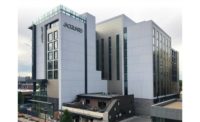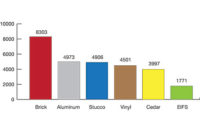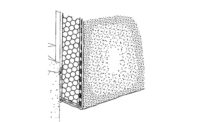At one time, 30 percent of the EIFS business was in the residential market. Today, the EIFS business in this market segment is less than 5 percent. This is the third in a series of articles about EIFS in the residential market. The following are ideas on how EIFS can re-enter the residential market and begin to regain market share.
In the United States the EIFS industry has continued to grow steadily since the recession ended in 2012. This growth has come without a solid presence in the residential market. It has been over twenty years since the water intrusion issues derailed the EIFS residential business. There are a few scattered areas where EIFS is being used on houses, but the once popular residential cladding is rarely seen in developments these days.
The EIFS industry survived the water intrusions of the mid 90s mainly due to its ability to re-engineer EIFS. The technologies that were introduced allowed the industry to not only survive in the construction market but enabled it to grow to unprecedented levels. So, if the industry was able to grow in the commercial market, why couldn’t it apply these same techniques in the residential market? Well, maybe it can!
The Current State of EIFS Residential
Today the problem with EIFS in the residential market is within its perception. Builders and real estate agents don’t want to build and sell EIFS houses because of the history. Obtaining EIFS insurance for the builders can also be a problem. While insurance is available at a reasonable cost, it’s not always easy to find unless builders contact an EIFS specialist insurance broker (see the insurance page on the EIMA website at eima.com). Simply put, EIFS has a bad image in the residential market and this stigma must be overcome before EIFS returns to the residential segment. So, what needs to be done in order to get back into the residential business? Let’s look at EIFS today and learn from the past.
EIFS Today
Today in the United States, EIFS is included in the National Building Codes for Residential (International Residential Code) and Commercial (International Building Code) construction. It is also in the National Energy Code. There is an EIFS standard in ANSI which is: ANSI/EIMA 99 A – 2017. The Department of Energy and the Oak Ridge National Labs conducted an extensive study. The DOE study confirmed that EIFS walls offer superior performance when compared to other wall claddings concerning energy savings and moisture control. The codes, standards, and testing certainly prove that EIFS is now not only viable cladding but an excellent one.
Look to Canada
We might want to look to the north for more answers to the residential questions. Residential EIFS in Canada has been going strong since the 80s. Today, EIFS clad houses can be found from Quebec to British Columbia. While the water intrusion news reached Canada, it didn’t greatly affect the EIFS housing business. In truth, they didn’t have the problems with the systems that were reported in North Carolina. EIFS is sold in Canada, based on its design flexibility just like in the U.S. but equally important is the energy conservation that EIFS cladding allows.
Canada is part of the Paris Climate Accord, which was put in place to respond to the global climate threat with the goal to conserve energy. This means that weather conditions become a factor when designing structures therefore making EIFS a great option. EIFS is included in the National Building Code as well as the National Energy Code.
The Canadians have also adopted a few EIFS techniques which were developed in the States. They have been using drainage systems for over 15 years. These systems also incorporate liquid applied WRBs, which must be applied in two coats.
The Canadians have had great success with EIFS in the residential market for many years. It is estimated that at least 25 percent of the EIFS sales in Canada come from the residential segment. The Canadian market has had a good track record with EIFS clad housing. Therefore, the conclusion one can draw is if it works in Canada where the climate is harsher, then it should certainly work in the lower 48 U.S. states.
More Finish Options are Available
The look of EIFS has changed over the years. In the 20th century, EIFS finish choices were mainly limited to several textured acrylic finishes with unlimited colors options. Today there are more design options from which to choose. EIFS can still be covered with the traditional acrylic finishes but now even brick or stone can be incorporated into the EIFS assembly.
This is one system from top to bottom with no breaks in the insulation and unlimited design options. Only EIFS can provide this flexibility and performance. With these new design options and continuous insulation, maybe the industry should look at EIFS differently for the residential business.
New Looks and a New Approach
As EIFS begins the journey back into the residential market maybe it needs a different approach. The buzz word today in the energy codes is continuous insulation or CI. Every cladding in America is trying to determine a way to incorporate CI. Well, EIFS is the original continuous insulation system. Furthermore, the 21st century EIFS is much different than the EIFS of the last century. Today’s EIFS incorporates WRBs, and drainage while allowing multiple finish options.
So, let’s consider looking at EIFS differently for the residential market. Start with the substrate. Most builders use OSB as the preferred substrate because it offers bracing and it is inexpensive. But there are problems when it is exposed to moisture. Although, it should be noted that WRBs do a good job protecting OSBs, but why take a risk when there are better options? Why not use a different substrate, one that is not subject to moisture, such as a glass faced exterior gypsum board? Yes, the down side to the glass faced boards is the higher costs and it may require some diagonal bracing at the corners, but it is, without a doubt, a much better substrate for EIFS.
The future EIFS homes will use WRBs over the substrate and all rough openings will be wrapped with WRBs. All systems will use drainage with proper detailing which includes flashing, caulking, etc. Applicators must be experienced and will be required to have current education certificates. Additionally, all materials that make up the EIFS assembly must come from one manufacturer.
There is one more thing to be considered. Perhaps a different name should be adopted for EIFS used in residential construction such as continuous insulation and finish system. Since we are essentially starting from scratch why not use a different name that doesn’t have the sigma that EIFS does in this market sector? And how do we get the new concept into the market?
How Do We Begin?
Here are four suggestions to facilitate EIFS return to the housing market. They are: learn from the past, promote the features, build a team, and start small. First, we need to learn from the past by making sure that the work is done properly and of high quality. Second, promote the features offered by EIFS clad homes which include curb appeal and design options, offering a variety of claddings and energy performance or CI. The next step would be to set up a team. This would be a group that is committed to building EIFS houses correctly. The team would consist of a manufacturer, a distributor, an applicator, a builder, and an insurance company who will write EIFS general liability insurance. With EIFS insurance on the front end the concern of risk is eliminated. This provides the builder, the real estate agent, and the future homeowner peace of mind about the home. The final point is to start small and make sure the jobs are done correctly, then see the business grow! The industry needs success to rebuild confidence in the systems.
The EIFS business needs to put the history behind it and return to the residential market. The return will take time and it will require hard work and dedication. But with the push for energy sustainability, EIFS or CIFS has the answer with a great look. A focused well thought out plan will surely help the industry get back into the residential market and accelerate the overall growth of the EIFS business.
Hopefully, this series of articles has helped you get a better understanding of the EIFS residential business. Will residential EIFS ever be 30 percent of the overall business? Who knows? But it’s time to begin the journey.
The Key Takeaways
- EIFS is in the building codes and the energy codes.
- The Department of Energy and the Oak Ridge National Labs concluded that EIFS walls offer superior performance when compared to other wall claddings concerning energy savings and moisture control.
- Canada has been successfully building EIFS houses for many years.
- Take a new approach to the residential market.
- There are four things to consider to get EIFS back into the residential market:
- Learn from the past
- Promote the features
- Build a team
- Start small









Report Abusive Comment